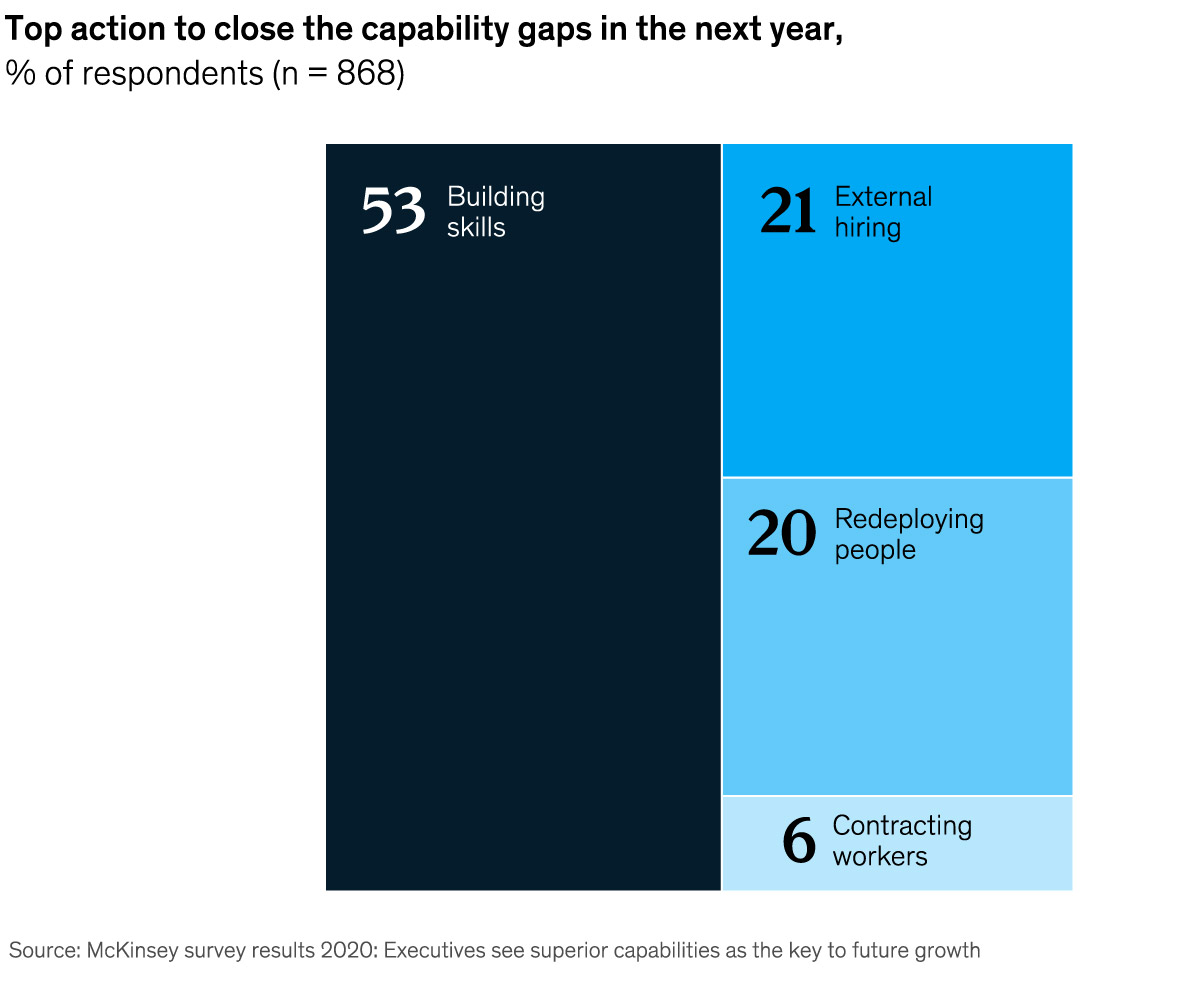
| Our best ideas, quick and curated | March 4, 2022
|
| This week, we look at how the definition of “data driven” will change for companies by 2025. Plus, two experts on why the social contract needs to change, and a McKinsey partner on how US manufacturing can become more dynamic, and why it matters so much. |
|
|
|
| What will the data-driven organization look like in three years? It’s a good bet that by 2025 smart workflows and seamless interactions among people and machines will be standard, and that most employees will use data to optimize nearly every aspect of their work. McKinsey put together a guide to
seven characteristics that will define the data-driven enterprise, the capabilities they will enable, and how to embed them in your organization. |
| Data assets as products. Today, an organization’s data function, if one exists outside of IT, manages data using top-down standards, rules, and controls. Data sets are stored across sprawling,
siloed, and often costly environments, making it hard for users to find and assess. By 2025, one of the characteristics of
a data-driven culture will be that data assets are organized and supported as products, regardless of whether they’re used by internal teams or external customers. These data products continuously evolve to meet the needs of consumers, leveraging DataOps (DevOps for data), and continuous integration and delivery processes and tools. |
| The chief data officer drives value. CDOs and their teams function as a cost center responsible for developing and tracking compliance with policies, standards, and procedures to manage data and ensure its quality. By 2025, they will operate as a business unit with profit-and-loss responsibilities. This unit will be responsible for developing a holistic enterprise data strategy (and embedding it as part of a business strategy) and creating new sources of revenue by monetizing data services and data sharing. Everyday applications include healthcare CDOs working in partnership with business units to deliver new subscription-based services for patients, payers, and providers. Bank CDOs could commercialize internal data-oriented services, such as fraud monitoring and anti-money-laundering services, on behalf of government agencies and other partners. |
| Data-ecosystem memberships are the norm. While data-sharing arrangements with external partners and competitors are increasing, they’re still uncommon. By 2025, large, complex organizations will use data-sharing platforms to collaborate on projects, both within and between organizations. Data marketplaces enable the exchange, sharing, and supplementation of data, ultimately empowering companies to build unique and proprietary data products and gain insights from them. For example, manufacturers could share data with partners and peers through open manufacturing platforms to build a more holistic view of global supply chains. |
| It’s a short jump in years to 2025, and organizations should act now to make it an equally short leap in data-driven capabilities. New forms of data are giving organizations unprecedented speed and transparency. In “Five insights about harnessing data and AI from leaders at the frontier,” four CEOs describe what goes into turning our world of data into a data-driven world. |
|
|

|
|
|
| PODCAST |
| It’s time to draw up a new social contract |
| “Our social contract is broken, and that is at the heart of why our politics is so divided and so many citizens around the world are disappointed and frustrated,” said Baroness Minouche Shafik, the director of the London School of Economics and Political Science. In this Forward Thinking podcast from the McKinsey Global Institute, she and fellow guest Andrew Sheng, distinguished fellow at the Asia Global Institute at the University of Hong Kong, discuss how the pandemic exposed the deep vulnerabilities many people around the globe face, and how they hope it will lead governments, companies, and other stakeholders to address these gaps. |
|
|

|
| MORE ON MCKINSEY.COM |
| Creating value, finding focus: Global Insurance Report 2022 | Where should insurers be active—regarding geography, lines of business, and position in the value chain—to renew value creation and themselves? Leadership teams need to capitalize on nine value levers. |
| M&A and Asia: Learning from the best | Mergers-and-acquisitions activity—both in number and size of deals—is climbing sharply. Here’s how Asian companies can use the lessons of the world’s most effective acquirers to boost their odds of a successful deal. |
| Five agility myths in energy and heavy industries | We explore five misconceptions associated with agility in these two sectors and look into how agility can drive value while addressing vital financial, operational, occupational, and environmental imperatives. |
|
|
|
|
|
| THREE QUESTIONS FOR |
| Asutosh Padhi |
| Asutosh Padhi, McKinsey’s managing partner for North America, helps companies with strategies related to technology and innovation, large-scale operating model redesign, and radical performance transformation.
|
|
|
|
|
| The decline of US manufacturing has hurt the country’s global competitiveness and contributed to rising inequality. How can its revitalization contribute to sustainable and inclusive growth? |
| Long before COVID-19 came to dominate our lexicon and our lives, the United States’ growth model was showing signs of strain. With years of uneven growth across sectors and geographies, some industries have flourished while others have faltered. Major hubs have boomed, but countless smaller communities have fallen through the cracks. |
| The labor market has become increasingly polarized, with the number of people in high- and low-wage jobs growing, while the number of people in middle-wage jobs has declined. These forces have stoked inequality, and the pandemic has served only to exacerbate this trend. Revitalizing US manufacturing—an industry that was once the beating heart of the country’s economy—could be fundamental to resolving these inequities while driving sustainable, inclusive growth. |
| Despite its outsize contribution to the economy, manufacturing has not enjoyed the same prosperity as other sectors in recent years. While it has grown in absolute terms, its relative global share has dropped to 17 percent, from 25 percent, in the past two decades. |
| Research from the McKinsey Global Institute found that restoring growth and competitiveness in 16 key manufacturing industries could boost annual GDP by more than 15 percent. Strengthening the sector could also address the pervasive supply chain issues wreaking havoc all over the world, easing short-term disruption caused by the pandemic while improving global competitiveness in the mid- to long term. |
| How can manufacturing become more dynamic? |
| The industry is undergoing seismic shifts toward a digital, automated, advanced, and sustainable future, but many smaller companies lack the tools they need to keep up. Private- and public-sector leaders can play a role in modernizing smaller manufacturing operations by offering financial programs and targeted business accelerators. |
| There are a record number of open jobs in US manufacturing today. In October last year, that figure topped one million—the highest on record and more than the entire population of San Francisco. |
| Attracting new talent will require strengthening the industry’s reputation among workers. To this end, companies should engage with schools and communities through university partnerships and trade school funding, which can help draw young people to viable jobs with opportunities for career progression. |
| What can leaders in manufacturing do to shore up the industry? |
| Leaders must focus their collective energy on three actions: urging investors and capital markets to turn their attention to manufacturing; enticing new talent and training the workforce for tomorrow’s jobs; and updating and digitizing the US manufacturing infrastructure. |
| Renewing capital stock could help the industry realize its full potential and get billions of dollars of investment flowing. This would not only serve to modernize and digitize manufacturing infrastructure but also trigger a a virtuous cycle of increased economic activity in communities across the country. |
| Reviving manufacturing could also add up to 1.5 million jobs, particularly among middle-skill workers, helping to tackle place-based inequalities, recalibrate the US labor market, and bolster the middle class. |
| — Edited by Barbara Tierney |
|
|
|
| BACKTALK |
| Have feedback or other ideas? We’d love to hear from you. |
|
 |
|
|
Did you enjoy this newsletter? Forward it to colleagues and friends so they can subscribe too.
Was this issue forwarded to you? Sign up for it and sample our 40+ other free email subscriptions here.
|
|
|
This email contains information about McKinsey’s research, insights, services, or events. By opening our emails or clicking on links, you agree to our use of cookies and web tracking technology. For more information on how we use and protect your information, please review our privacy policy.
|
|
You received this email because you subscribed to The Shortlist newsletter.
|
|
|
|
Copyright © 2022 | McKinsey & Company, 3 World Trade Center, 175 Greenwich Street, New York, NY 10007
|
|
|
|






